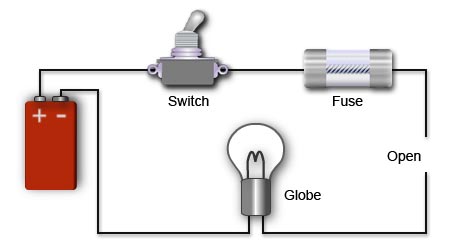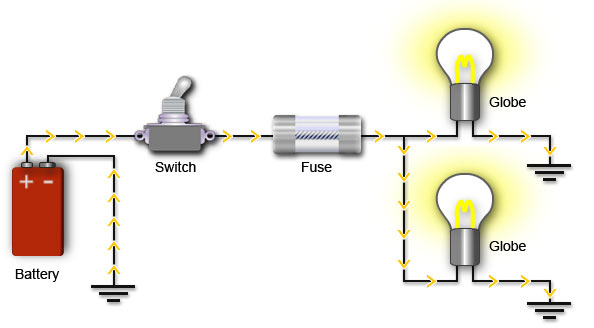Electrical principles - Circuits
Conditions
The following conditions can exist in any given circuit:
- open – no current can flow
- closed – current is flowing
- shorted – current is flowing through a shorter path and load in the circuit is bypassed. This is a fault condition.
Open circuit
An 'open circuit' exists when there is a break or gap in the circuit.

Open circuit condition
The above circuit is 'open'. Current cannot flow around the circuit due to the break in the wiring.
Open circuits can be caused by one or more of the following:
- broken wire
- poor connection
- loose terminal
- blown fuse
- tripped circuit breaker
- faulty switch
- blown globe.
Note: A circuit is open when a switch is in the 'off' position.
Closed circuit
A closed circuit condition exists when a circuit is complete allowing current to flow.

Closed circuit condition
With the switch closed the current has a complete path. The circuit is 'closed' and operates. Closed circuit as a fault would only occur when a switch is jammed in the 'on' position.
Short circuit
A short circuit exists when the original path of current flow is altered and a 'shorter' than normal path for current flow exists.

Short circuit condition
In the diagram above, when the switch is closed, current flows from the battery through the switch to point 'A'. From here, most of the current flow will travel through the link to point 'B', returning to the battery. A small amount will flow through the globe back to the battery.
Most of the current will flow through the link ('A' to 'B') as it has less resistance than the globe.
As the circuit's resistance has decreased to almost zero, the current flow in the circuit will increase. A short circuit results in a rise of current flow to a dangerous level that, without protection, will cause burning of wiring and possible component damage.
In the diagram, the high current flow would burn out the fuse. This would 'open' the circuit to protect the wiring and components.
Causes of short circuits include the following:
- worn or damaged wiring insulation
- wire squashed or jammed between components
- tools dropped across or accidental contact between positive and negative
- incorrectly connected ammeter
- active wire incorrectly connected or joined to neutral position.
Circuit conditions
Use the following diagram to create different circuit conditions.
To do this:
- select the fuse and switches to open and close them
- select submit to get feedback.



